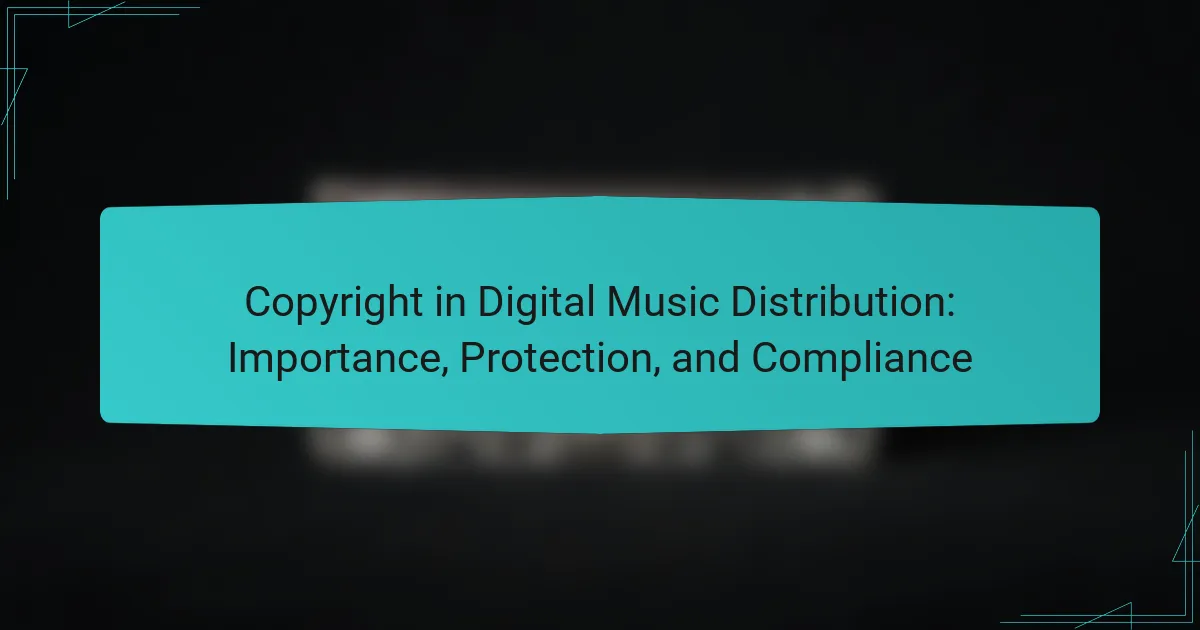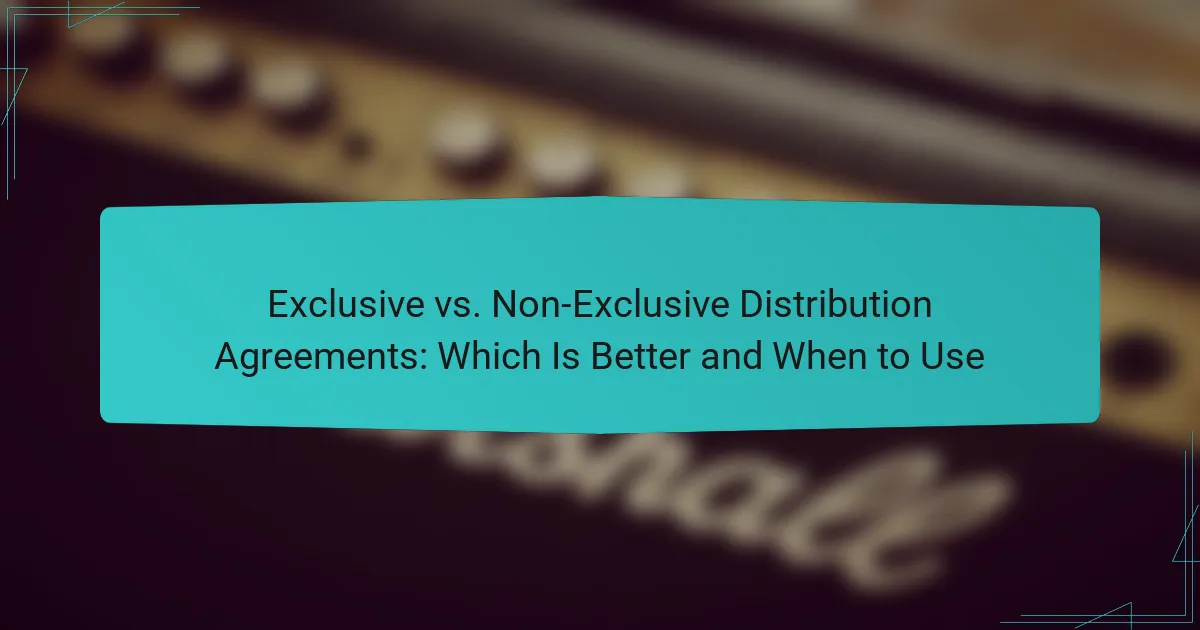Termination clauses in digital music distribution agreements are essential for defining the circumstances under which either party can end the contract. For artists and distributors alike, comprehending these clauses is vital to effectively manage their rights and obligations, as well as to navigate potential impacts on revenue and future opportunities.
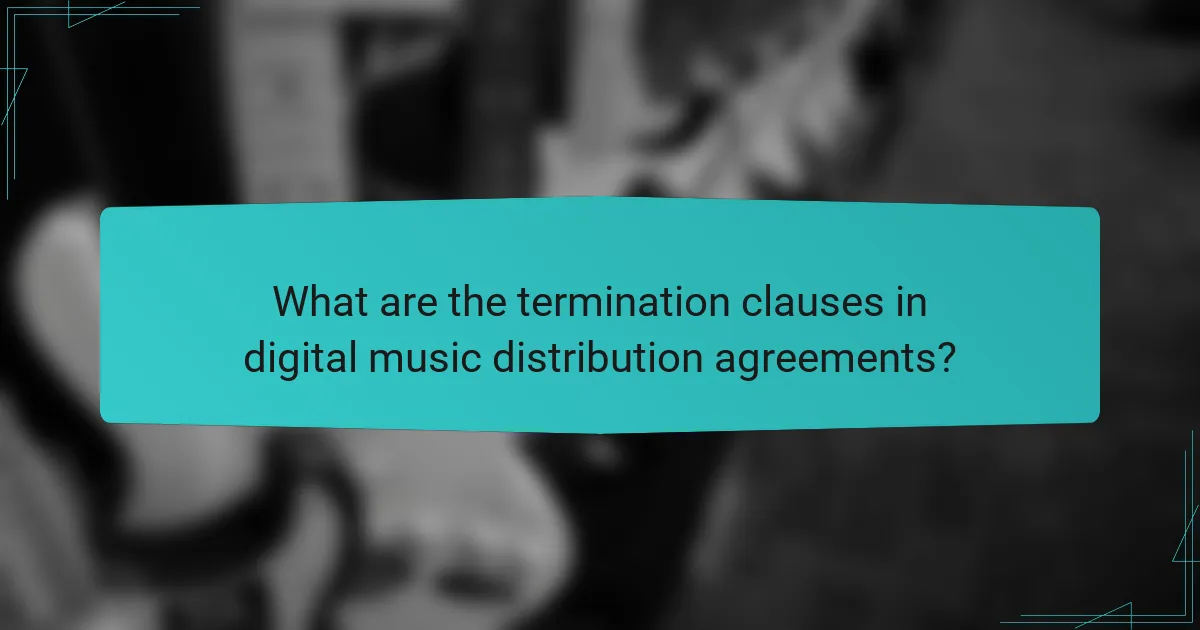
What are the termination clauses in digital music distribution agreements?
Termination clauses in digital music distribution agreements outline the conditions under which either party can end the contract. Understanding these clauses is crucial for artists and distributors to manage their rights and obligations effectively.
Standard termination clauses
Standard termination clauses typically allow either party to terminate the agreement after a specified period, often ranging from one to three years. These clauses may require a written notice and can include conditions such as failure to meet sales targets or breaches of contract. It is essential to review these terms to avoid unexpected contract extensions.
Mutual termination conditions
Mutual termination conditions enable both parties to agree to end the contract without penalty. This can occur if both the artist and distributor find the partnership unproductive or if market conditions change significantly. Clear communication and documentation of the mutual agreement are vital to prevent disputes.
Unilateral termination rights
Unilateral termination rights allow one party to terminate the agreement without the consent of the other, often under specific circumstances such as breach of contract or insolvency. Artists should be cautious with these clauses, as they can lead to sudden contract termination without recourse. Understanding the grounds for unilateral termination is essential for protecting one’s interests.
Termination notice periods
Termination notice periods specify how long in advance one party must inform the other before ending the agreement, typically ranging from 30 to 90 days. This period allows both parties to prepare for the transition and settle any outstanding obligations. Artists should ensure that the notice period is reasonable and manageable.
Consequences of termination
The consequences of termination can include the cessation of distribution rights, the return of master recordings, and potential financial settlements. Artists may also lose access to promotional support and marketing services provided by the distributor. It’s crucial to understand these implications to make informed decisions about contract termination.
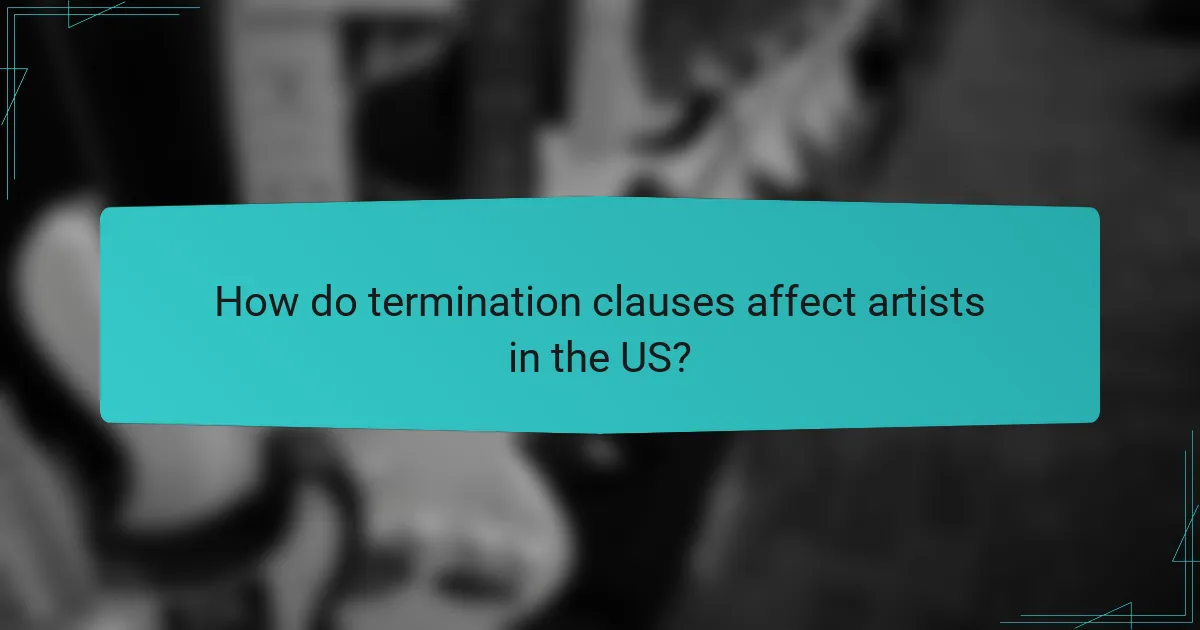
How do termination clauses affect artists in the US?
Termination clauses in digital music distribution agreements allow artists to end their contracts under specific conditions, impacting their rights and future opportunities. Understanding these clauses is crucial for artists to navigate their relationships with distributors effectively.
Impact on royalties
Termination clauses can significantly affect how and when artists receive royalties. If an artist terminates their agreement, they may lose access to ongoing royalty payments, especially if the contract stipulates that royalties are only paid while the agreement is active.
Artists should review their contracts to understand the timing of royalty payments upon termination. In some cases, they might receive a final payout, while in others, they may forfeit future earnings tied to their music.
Rights to master recordings
When an artist terminates a distribution agreement, the rights to their master recordings can be a contentious issue. Many contracts specify that the distributor retains rights to the recordings for a certain period, even after termination.
Artists must ensure they clearly understand their rights regarding master recordings. If the contract allows, they should negotiate terms that enable them to regain full control of their music upon termination.
Future distribution options
Termination clauses can limit an artist’s future distribution options. If an artist ends a contract, they may face restrictions on working with other distributors for a specified duration, known as a “non-compete” clause.
To avoid complications, artists should seek to negotiate terms that allow them to pursue new distribution opportunities immediately after termination. This flexibility can be vital for maintaining momentum in their careers.
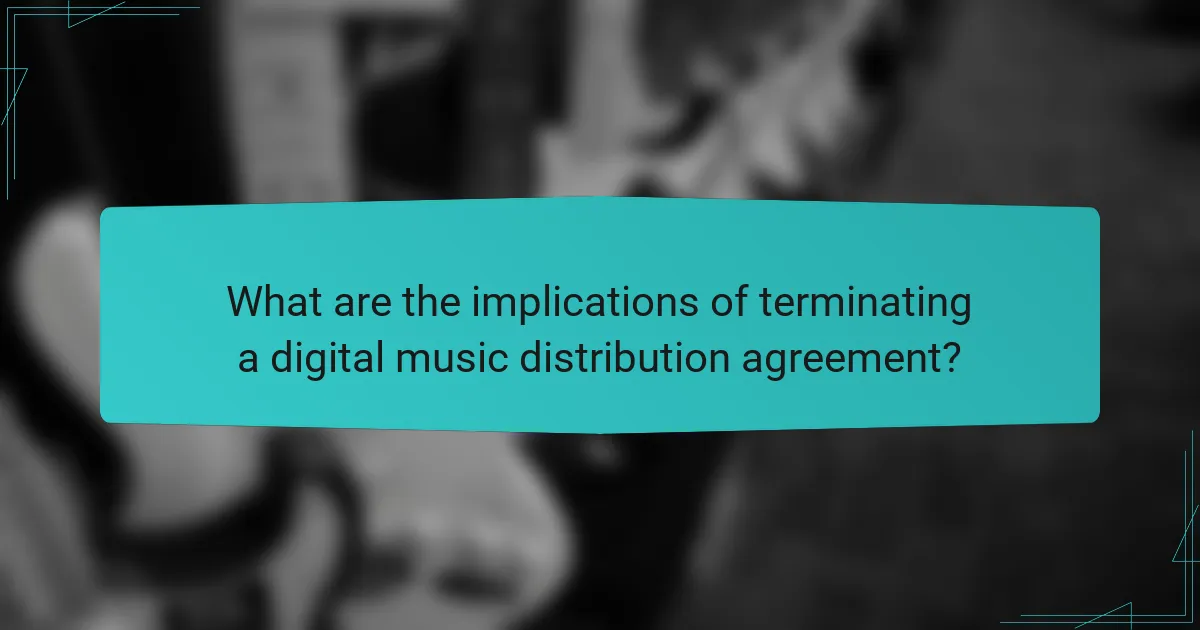
What are the implications of terminating a digital music distribution agreement?
Terminating a digital music distribution agreement can significantly impact an artist’s revenue, reputation, and legal standing. Understanding these implications is crucial for making informed decisions about the future of music distribution.
Loss of revenue streams
One of the most immediate consequences of terminating a digital music distribution agreement is the potential loss of revenue streams. Artists typically earn income from streaming platforms, downloads, and licensing, all of which may cease if the agreement is ended. This can lead to a sharp decline in earnings, especially if the artist relies heavily on digital sales.
To mitigate this risk, artists should evaluate alternative distribution options before termination. Exploring new partnerships or self-distribution methods can help maintain revenue flow. It’s advisable to have a plan in place to transition smoothly to a new distribution model.
Reputation management issues
Terminating a distribution agreement can also affect an artist’s reputation within the industry. If the termination is perceived as a breach of trust or a sign of instability, it may deter future collaborations with labels or distributors. Maintaining a positive public image is essential for long-term success.
To manage reputation effectively, artists should communicate transparently about their reasons for termination. Engaging with fans and industry professionals through social media or press releases can help clarify intentions and maintain goodwill.
Legal ramifications
Legal implications are another critical aspect to consider when terminating a digital music distribution agreement. Depending on the terms of the contract, artists may face penalties, loss of rights, or even lawsuits. It’s essential to review the agreement carefully to understand any obligations or consequences tied to termination.
Consulting with a legal professional who specializes in music contracts can provide valuable insights. They can help navigate the complexities of the termination process and ensure that the artist’s rights are protected throughout the transition.

What should artists consider before terminating their agreement?
Before terminating a digital music distribution agreement, artists should carefully assess the implications of their decision. This includes understanding the contract terms, potential financial repercussions, and the availability of alternative distribution options.
Reviewing contract terms
Artists must thoroughly review the specific terms outlined in their distribution agreement. Key elements to focus on include the duration of the contract, any notice periods required for termination, and any penalties or fees associated with ending the agreement prematurely.
Understanding these terms can help artists avoid unexpected costs or complications. For instance, some contracts may require a notice period of 30 to 90 days, during which the artist must continue to fulfill their obligations.
Consulting legal professionals
Engaging a legal professional who specializes in entertainment law can provide valuable insights into the termination process. An attorney can help artists interpret complex legal language and advise on the potential risks of terminating the agreement.
Legal professionals can also assist in negotiating terms with the distributor or exploring options for a smoother exit. This step is crucial, as improper termination could lead to disputes or loss of rights to the music.
Evaluating alternative distribution methods
Before making a final decision, artists should explore alternative distribution methods that may better suit their needs. Options include self-distribution through platforms like Bandcamp or utilizing new aggregators that offer favorable terms.
Artists should compare the costs, reach, and support offered by different distribution channels. This evaluation can help ensure that they choose a method that aligns with their goals and maximizes their revenue potential.

What are the best practices for negotiating termination clauses?
Best practices for negotiating termination clauses in digital music distribution agreements include understanding industry standards, incorporating flexibility, and ensuring clarity in language. These strategies help protect the interests of both parties while providing a clear framework for ending the agreement if necessary.
Understanding industry standards
Familiarizing yourself with industry standards is crucial when negotiating termination clauses. Many agreements typically include provisions for termination due to breach, insolvency, or mutual consent. Knowing these common practices can help you set realistic expectations and identify any unusual terms that may require further negotiation.
For example, a standard notice period for termination might range from 30 to 90 days, allowing both parties adequate time to prepare for the end of the agreement. Understanding these norms can guide your discussions and help you avoid pitfalls.
Incorporating flexibility
Flexibility in termination clauses can be beneficial for both parties. Consider including options for early termination under specific circumstances, such as failure to meet sales targets or changes in market conditions. This allows for adaptability in a rapidly changing digital landscape.
Additionally, you might negotiate a tiered termination process, where different conditions trigger varying notice periods. This can provide a balance between security and responsiveness, ensuring that both parties can act swiftly if needed.
Ensuring clarity in language
Clear and precise language is essential in termination clauses to avoid misunderstandings. Ambiguities can lead to disputes, so it’s important to define key terms and conditions explicitly. For instance, specify what constitutes a breach and the exact process for initiating termination.
Using straightforward language helps both parties understand their rights and obligations. Consider having a legal professional review the clauses to ensure they are enforceable and unambiguous, which can save time and resources in the long run.

How do termination clauses differ across digital distribution platforms?
Termination clauses in digital distribution agreements vary significantly among platforms, influencing how and when an artist can end their contract. Understanding these differences is crucial for artists to manage their rights and obligations effectively.
Spotify distribution agreements
Spotify’s distribution agreements typically include specific termination clauses that allow artists to end their contracts under certain conditions. Generally, artists can terminate their agreement if they provide written notice, usually ranging from 30 to 90 days, depending on the terms negotiated.
One key aspect to consider is that Spotify may retain the right to distribute the music for a limited period even after termination, which means artists should clarify the duration of this post-termination period. Additionally, artists should be aware of any financial implications, such as outstanding payments or royalties that may affect their decision to terminate.
It’s advisable for artists to review their agreement carefully and consult legal counsel if needed, to ensure they fully understand the termination rights and obligations specific to Spotify. This proactive approach can help avoid potential disputes and ensure a smoother transition if they choose to move to another platform.

